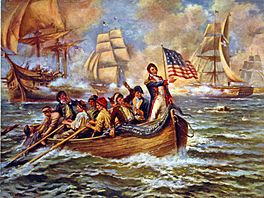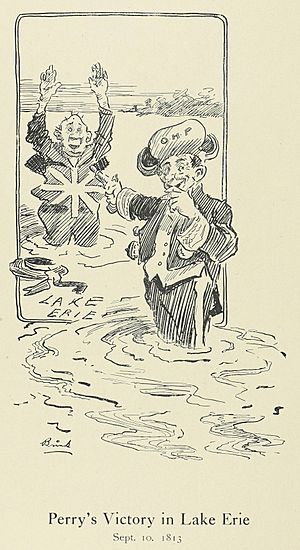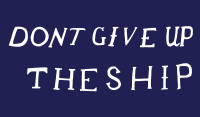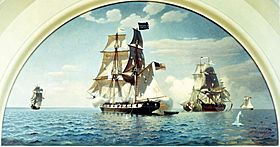Oliver Hazard Perry facts for kids
Quick facts for kids
Commodore
Oliver Hazard Perry
|
|
|---|---|
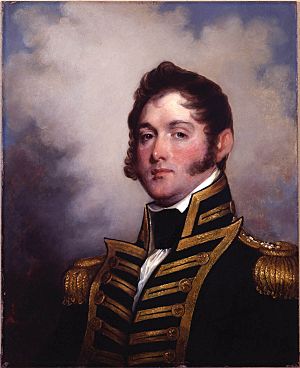
The Hero of Lake Erie
|
|
| Born | August 23, 1785 South Kingstown, Rhode Island, United States |
| Died | August 23, 1819 (aged 34) Trinidad |
| Place of burial | |
| Allegiance | |
| Service/ |
|
| Years of service | 1799–1819 |
| Rank | Commodore |
| Commands held |
|
| Battles/wars |
|
| Awards | Congressional Gold Medal |
| Relations |
|
Oliver Hazard Perry (born August 23, 1785 – died August 23, 1819) was a famous American naval commander. He was born in South Kingstown, Rhode Island, and came from a family of important naval officers. His father, Christopher Raymond Perry, was a U.S. Navy Captain, and his younger brother, Matthew C. Perry, also became a well-known Commodore.
Perry served in several conflicts, including the Quasi-War against France and the Barbary Wars in the Mediterranean Sea. He also fought pirates and worked to stop the slave trade in the Caribbean. However, he is most famous for his heroic actions during the War of 1812. In 1813, he led American forces to a major victory in the Battle of Lake Erie. This earned him the nickname "Hero of Lake Erie" and a special award called the Congressional Gold Medal.
Perry is remembered for his inspiring battle flag, which read: "Don't Give Up the Ship." These words honored his friend, Captain James Lawrence, who said them as he was dying. Perry is also known for his short and famous message to General William Henry Harrison after the Battle of Lake Erie: "We have met the enemy and they are ours."
Contents
Oliver Hazard Perry grew up in Tower Hill, Rhode Island. He dreamed of a career in the United States Navy from a young age. He was the oldest of five boys. His family had a long history of naval service. His mother taught him and his brothers to read and write. He was also a regular churchgoer.
At just 13 years old, Perry became a midshipman in the U.S. Navy in 1799. This was thanks to his father's influence. His first ship was the USS General Greene, commanded by his father. They sailed to Cuba to protect American merchant ships. Perry experienced his first combat in 1800 off the coast of Haiti.
During the First Barbary War, Perry served on several ships, including the USS Adams and USS Nautilus. He later became the second-in-command of the Nautilus. He also helped build gunboats in Rhode Island.
In 1809, Perry commanded the ship USS Revenge. He patrolled to enforce trade laws and even rescued an American ship from Spanish territory. In 1811, the Revenge ran aground and was lost. Perry made sure his crew was safe before leaving the ship himself. A later investigation cleared him of any blame. After this, Perry took a break from the Navy. In May 1811, he married Elizabeth Champlin Mason. They had five children together.
The War of 1812 and Lake Erie
When the War of 1812 began, the British Navy controlled most of the Great Lakes. The American Navy was much smaller. This allowed the British to advance in the Great Lakes region. Naval commanders like Perry played a crucial role in the war.
Perry asked to lead the American naval forces on Lake Erie. He was put in charge of building a new fleet at Erie, Pennsylvania. Perry carefully planned his battles, much like the famous British Admiral Horatio Nelson. He told his captains to stay close to his flagship, the Lawrence, and to fight the enemy up close.
Hero of Lake Erie
On September 10, 1813, Perry's fleet fought the British in the Battle of Lake Erie. Perry famously declared, "If a victory is to be gained, I will gain it." At first, the battle was tough for the Americans. Perry's ship, the USS Lawrence, was badly damaged. The British commander thought Perry would surrender.
But Perry remembered the words "DON'T GIVE UP THE SHIP." He personally fired the last shot from the Lawrence. Then, he and a few remaining crew members rowed through heavy gunfire to another ship, the USS Niagara. Once on board the Niagara, Perry took command. He steered the Niagara towards the damaged British ships. His forces attacked until the British had to surrender.
Even though he won the battle on the Niagara, Perry accepted the British surrender on the deck of the Lawrence. He wanted the British to see how much his men had sacrificed. His battle report to General William Henry Harrison was very brief and famous: "We have met the enemy and they are ours; two ships, two brigs, one schooner and one sloop."
This was the first time in history that an entire British naval squadron had surrendered. This victory was very important for the United States. It helped open up Canada for a possible invasion. It also protected the entire Ohio Valley. The loss of the British fleet directly led to another important American victory, the Battle of the Thames. In this battle, British forces were defeated, and important Native American leaders like Tecumseh were killed.
Perry was involved in nine battles around Lake Erie. His leadership greatly influenced the outcome of all these victories. These included capturing Fort George, Ontario, destroying British supplies, building the Erie fleet, and winning both the Battle of Lake Erie and the Battle of the Thames.
The Battle Flag
The phrase "Don't give up the ship" became Oliver Hazard Perry's battle cry. He adopted it after Captain James Lawrence said these words as he was dying. Lawrence was wounded on his ship, the Chesapeake, in June 1813. When Perry arrived at Presque Isle, he learned of Lawrence's death. He decided to name one of his ships Lawrence in his friend's honor.
Perry also needed a battle flag. He chose Lawrence's dying words for the flag. A woman named Margaret Forster Steuart and her family made the flag for Perry. Today, Perry's flag is on display at Bancroft Hall at the U.S. Naval Academy in Annapolis.
Perry and Elliott's Disagreement
After the Battle of Lake Erie, a disagreement arose between Perry and Captain Jesse Elliott, who commanded the Niagara. In his first report, Perry praised Elliott. However, some junior officers later said that Elliott did not bring the Niagara into the fight soon enough. They felt that the Lawrence took too much damage because it wasn't properly supported.
When Perry transferred to the Niagara during the battle, the meeting between him and Elliott was tense. Elliott offered to rally the other ships, and Perry agreed. Elliott was not on the Niagara when Perry turned it back into the fight. Elliott later argued that he didn't receive clear signals. This disagreement continued for many years.
Congressional Gold Medal
On January 6, 1814, Perry received a Congressional Gold Medal. This was a high honor from Congress. He was also promoted to the rank of Captain. This medal was one of 27 given out during the War of 1812.
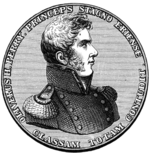 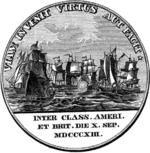 |
|
Elliott also received a Congressional Gold Medal. This further fueled the disagreement between him and Perry.
Later Life and Death
In 1818, Perry bought a large house in Newport, Rhode Island. In 1819, he sailed to the Orinoco River in Venezuela. His mission was to stop piracy and maintain good relations with new South American countries. He sailed upriver on the schooner USS Nonsuch to meet with President Simón Bolívar.
Perry signed an agreement to fight piracy. However, many of his crew, including Perry himself, became sick with yellow fever. Despite efforts to reach Trinidad for medical help, Perry died on board the Nonsuch on August 23, 1819. It was his 34th birthday. He was first buried in Trinidad with great honors. His remains were later brought back to the United States in 1826. He was reburied in Newport, Rhode Island.
Family and Legacy

Oliver Hazard Perry's parents were Christopher Raymond Perry and Sarah Wallace Alexander. Through his mother, Perry was related to the famous Scottish hero William Wallace.
Perry and his wife, Elizabeth, had five children. Four of them lived to adulthood:
- Christopher Grant Champlin Perry (1812–1854), who became a Brigadier General.
- Oliver Hazard Perry II (1813–1814), who died as a baby.
- Oliver Hazard Perry, Jr. (1815–1878), who also served in the Navy.
- Christopher Raymond Perry (1816–1848), who served in the Army.
- Elizabeth Mason Perry, who married a reverend.
Many places are named in Oliver Hazard Perry's honor. These include schools, towns, and counties across the United States.
Monuments and Art
The main monument honoring Perry is the Perry's Victory and International Peace Memorial in Put-in-Bay, Ohio. It's a tall, impressive tower built between 1912 and 1915.
Other monuments include:
- A plaque at Trinity Episcopal Church in Newport, Rhode Island.
- Statues in Cleveland, Ohio; Newport, Rhode Island; Buffalo, New York; and Erie, Pennsylvania.
- A monument at Misery Bay in Presque Isle State Park, Pennsylvania.
- A statue at the Rhode Island State House.
- The family farm in South Kingstown, Rhode Island, is also a historic site.
Many paintings also show Perry and his famous victory. These include:
- Perry's Victory on Lake Erie (1865) by William Henry Powell in the Ohio Statehouse.
- Battle of Lake Erie (1873) by William Henry Powell in the U.S. Capitol.
- Battle of Lake Erie (around 1911) by Edward Percy Moran.
Ships Named After Perry
Many ships in the U.S. Navy have been named in honor of Commodore Oliver Hazard Perry:
- USS Perry (1843), a sailing ship.
- USS Commodore Perry (1859), an armed ferry.
- USS Perry (DD-11), a destroyer.
- USS Perry (DD-340), another destroyer.
- SS Oliver Hazard Perry, a cargo ship.
- USS Perry (DD-844), a destroyer.
- USS Oliver Hazard Perry (FFG-7), a guided-missile frigate. This ship was the first of a whole class of frigates named after him, called the Oliver Hazard Perry-class frigates.
- SSV Oliver Hazard Perry, a modern tall ship used for education.
See also
 In Spanish: Oliver Hazard Perry para niños
In Spanish: Oliver Hazard Perry para niños


